More Than Poses: Yoga's Healing Wisdom for Eating Disorders
"This is yoga: you and your body, together finding the way."
-Lauren Peterson, from Yoga and Eating Disorders
My first inhale of a yoga class--that deep, sweet breath in--fills me. With my eyes closed and face soft, I send the air out with a purposeful exhale. Each round of breath draws me more inward. The rhythm at once soothes and awakens me. I am still and moving at the same time. It’s no wonder that stepping on my yoga mat feels like coming home every time. In a way, that’s exactly what happens. I land inside and reconnect with the dynamic dimensions, textures, colors, and shapes that make me whole.
If I had not taken that first inhale on a yoga mat years ago, I'm unsure if my healing path from anorexia would have been as empowering or lasting.
Yoga teaches me how to connect from the inside out. I rest my mind on my breath as I embody the characteristics that are essential to my ability to sustain a well-supported recovery and fulfilling life. I experience my strength and confidence in warrior poses, courage in wheel pose, grace in dancer's pose, openness in triangle pose, peace in hero's pose, and support in child's pose.
Years of yoga and recovery have also fostered in me a steadfast practice of svadhyaya, the Sanskrit term for "self-study," which means turning inward and observing your actions, reactions, emotions, and habits. From the awareness born out of self-study we can tap into insights about our relationships with ourselves and others as well as food and our bodies. The vast and illuminating wisdom of yoga philosophy provides guiding principles to support those shifts--big and small--that our self-study reveals we must make to suffer less in our lives. Yoga with a capital "Y" includes poses, philosophy, and other quiet practices like meditation to cultivate inner resilience.
In 2016, Carolyn Costin, founder of Monte Nido, the first residential treatment program to bring together Eastern and Western healing modalities, including yoga and meditation, published Yoga and Eating Disorders. This important book combines the wisdom of 20 experts on the topic and shows how and why yoga’s mind-body connection facilitates treatment and recovery. I have the humbling honor of teaching yoga at the new Monte Nido center that opened this past summer in Villanova, PA.
As a yoga therapist in the treatment setting and in my private practice, I teach others recovering from eating disorders yoga poses, philosophy, and mindfulness practices to help them establish new behaviors, patterns, and language to bolster and fortify their healing process. The overarching goal of my work is to hold space for clients to uncover the rich perspectives and experiences that emerge when their body and mind in dialogue with one another.
Carolyn's book has become my second bible--an invaluable resource for my personal life and professional work. I've underlined and highlighted and notated the heck out of my copy! What I appreciate most about this book is its balanced presentation of how both yoga poses and yoga philosophy work together to support deep healing. From yogic concepts like the koshas, yamas, niyamas, and samskaras, to personal narratives to templates for yoga workshops for recovery and how to incorporate yoga into therapy and treatment, Carolyn's book offers eating disorder practitioners an abundance of knowledge and ideas to work with. For those in recovery, this book is a beautiful introduction to the myriad ways yogic practices and concepts can make a profound difference. It also gives individuals fresh ideas and language to work with and try out as they travel the highs and lows of their recovery path.
It's because I so deeply believe in the power of yoga, this book, and its place in eating disorder literature that I share about this book with you. Now, have experiencing both sides of the equation--patient and practitioner--I am so grateful to Carolyn and each of the contributors who so poignantly captured the healing wisdom of Yoga.
I sign off with a deep, sweet, long inhale, and I wish you the peace that such inner stillness and knowing can heal.
Namaste.


